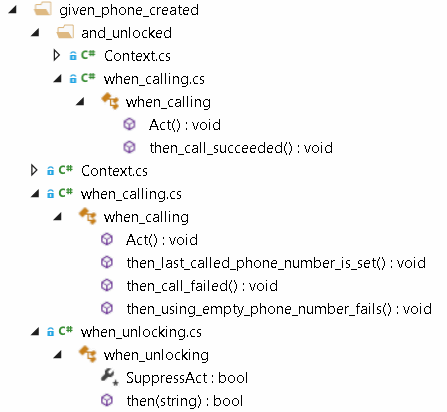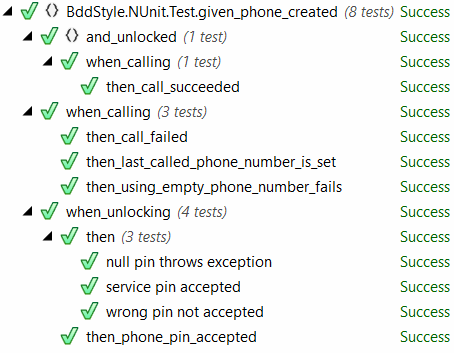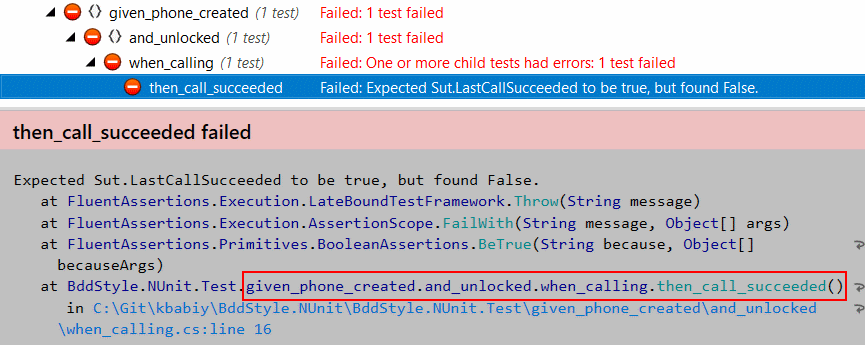Provides set of base classes to structure Unit Tests in the BDD shape (Given-When-Then, GWT)
This projects gives an approach to solving few common tasks to achieve high quality UT code:
- Maintainable
- DRY and reusable
- Allowing abstractions
- e.g. reusing common setup
- Concise scope
- With descriptive naming
- Errors easy and fast localization
- Isolated: one assertion per test
Note: this project contains two packages, depending on your UT framework of preference:
- BddStyle.NUnit - used as an example below
- BddStyle.xUnit
Few links:
- Install Nuget package to your unit test project
Install-Package BddStyle.NUnit
- (optional) For your convenience import Resharper templates to generate tests faster
- ReSharper => Tools => Templates Explorer => Import button
- Tests are structured like: Given —< When —< Then
- Note that it is one-to-many ( —< ) relationship between the components
- It can be read as: Given [initial context], When [event occurs], Then [ensure some outcomes]
-
Given section describes the state of the world before you begin the test case in this scenario Can be thought of as the pre-conditions to the test
- is represented by a folder in the solution structure
- usually (optionally) contains Context class, which is a place to write the test setup
- examples: given_tested_class; given_particular_environment_state
-
When section is the case that you are specifying
- is represented by a class located in the Given specified folder
- usually this class is inherited from the Context class (optionally, otherwise inherited from ContextBase class - see below for details) therefore inheriting setup of the parent Given
- example: when_sut_method1_is_called.cs
-
Then section describes the changes you expect due to the specified behavior
- is represented by a method in the When class marked with NUnit.Framework.TestAttribute
- contains check of one expectation from the testcase execution results
- examples: then_expected_result_is_returned(); then_exception_is_thrown();
-
How example solution looks like:
How example tests logical structure looks like:
Troubleshooting and error localization:
Example of the proposed inheritance model is: ContextBase -> given_description.Context.cs -> and_specified_given.Context -> when_class.cs
-
ContextBase - an entity provided by this library being the root entity and providing methods to override
- Members
- Arrange(Async) - is called before each testcase execution to set up the preconditions. Is usually overriden in the Context (being the contents of the Given setup)
- Act(Async) - contains the testcase actions to perform. Is usually overriden in the When class
- Cleanup - is called after each testcase execution to cleanup the test consequences. Is usually overriden in the Context when such a cleanup is needed
- SuppressAct - is a virtual property to allow disabling automatic Act execution (presuming it is going to be manually called in the test body). It is a solution to improve data-driven tests (aka TestCase in NUnit) implementation
- Members
-
As it can see from the example, nested Given is supported within the approach by creating nested folder (and Context class) with the methods overriden to specify the setup
- bdc: create Context
- bdu: create When class
- bdt: create Then method (test in the When class)
- Fluent Assertions - lib for rich and declarative UT assertions
- Moq - convenient mocking framework
- NCrunch - continuous testing solution for VisualStudio
- Konstantin Babiy - main contributor and current owner
- Kirill Medvedev - originally introduced the idea and started the project



